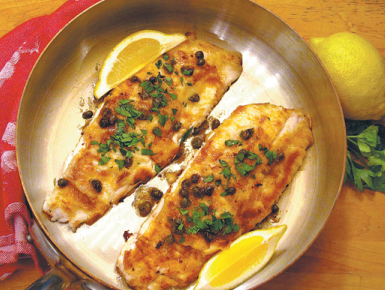Sole Meuniere: Improving on perfection
 |
|
Sole Meuniere, a dish from a recipe by Sara Moulton.[Photo/Agencies] |
Julia Child was able to remember the single most decisive moment in her life with photographic clarity. It was her first bite of her first meal in France, a fish dish called Sole Meuniere. That first forkful, she wrote, was "a morsel of perfection," and it set her on the path to become the Julia we'd come to know and love.
Though it is indeed a classic of French cuisine, Sole Meuniere-a filet of fish dipped in flour, then sauteed in butter-isn't terribly complicated. But it's one of those dishes that really benefits from attention to detail. And in the interest of improving on "perfection," I've added a few new details.
Let's start with the fish. Julia was served Dover sole. Thick, firm and delicious, Dover sole is widely available in Europe, but not in the United States. In fact, much of the "sole" sold on these shores isn't sole at all but a kind of flounder... and much of that is endangered due to overfishing and should be avoided. So opt for Pacific flounder or Pacific sole or just reach for any firm-fleshed white fish that is not endangered.
Still, most white fish, even Dover sole, is a tad bland. Accordingly, Sole Meuniere is always finished with a little pick-me-up of lemon and salt. This recipe starts with acid and salt in the form of a salty buttermilk brine, which deeply pre-seasons the fish.
Typically, Sole Meuniere calls for all-purpose flour, but if you can find "instantized" flour, aka Wondra, grab it. The fish is crispier when it's coated with Wondra. Two important final notes: Wait until the pan is almost smoking before adding the fish, and don't flour the fish until the last minute, which will prevent it from becoming gummy.
Given that we've added capers and lemon slices to this version, it's more properly called Sole Grenobloise than Sole Meuniere. Whatever, it's delish.
Sole Meuniere
Start to finish: 30 minutes plus 1 to 3 hours marinating time
Servings: 4
1 cup buttermilk
1 teaspoon kosher salt
1 1/4 to 1 1/2 pounds firm white fish fillets
1 small lemon
3 to 4 tablespoons vegetable oil
1/2 cup instantized flour
3 tablespoons unsalted butter, cut into several pieces
1 tablespoon drained capers Chopped fresh parsley for garnish
In a resealable plastic bag combine the buttermilk and salt and stir with a small whisk or fork until the salt is dissolved. Add the fish fillets, making sure they are coated with the buttermilk, seal the bag and place it in the refrigerator. Let the fish marinate for at least 1 hour and preferably 3 hours.
While the fish is marinating, cut off the top and the bottom of the lemon. Place it on the cutting board cut-side down. Starting at the top, following the curve of the lemon, cut off the rind and the pith. Working over a small bowl to catch any juice, cut between the membranes to separate the lemon into segments. Reserve both the segments and the juice.
In a large nonstick skillet heat half the oil over medium-high heat.
Remove half the fish from the buttermilk, letting the excess drip off, and dip it in the flour, coating it on all sides and shaking off the excess. Add it to the pan and cook it until golden on both sides and just cooked through, about 3 minutes total. Transfer the fish to a platter and cover it loosely with foil. Repeat the procedure with the remaining oil and fish. Discard any oil left in the pan.
Add the butter, the capers and a hefty pinch of salt to the skillet and cook over medium heat, swirling the butter, until it is golden. Add the lemon segments and cook 2 to 3 minutes. Pour the sauce over the fish, sprinkle with the parsley and eat right away.
Sara Moulton is host of public television's Sara's Weeknight Meals. Her latest cookbook is Home Cooking 101.
ASSOCIATED PRESS
















